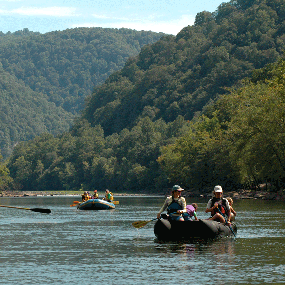
NPS photo/Gary Hartley 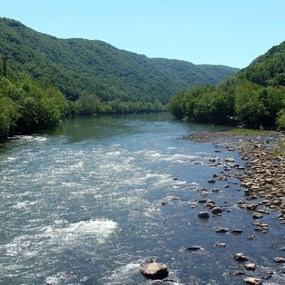
NPS photo/Dave Bieri Water Resources The primary thrust of the natural resource management activities at New River Gorge National Park and Preserve is the protection of the water resources. The quality of the surface water resources of the New River has been studied in recent years by both the State of West Virginia and park Resource Management staff. Data from these studies suggest the presence of metals, organic contaminants and influx of raw sewage are common in many tributaries of the New River. Metals contamination, resulting from mining activities and or urban surface flows, are present in most tributaries, with four streams, Wolf Creek, Arbuckle Creek, Dunloup Creek and Piney Creek, showing pronounced values. Other sources of pollutants within park boundaries include unlined landfills, illegal dumps, pesticide sprayed directly into the New River, agricultural runoff, road salt runoff, direct discharge of residential sewage, inadequate municipal sewage treatment facilities, recreation waste streams, and industrial discharges. Pollution of rural streams by fecal coliform bacteria is a widespread issue. Since fecal coliform bacteria live in the gut of warm-blooded animals, fecal contamination of rural streams can come not only from humans, but also from livestock, pets, and wildlife (including birds). Several research efforts have been made to understand the role of these various potential sources of bacteria. One of these studies was conducted in New River Gorge by the U.S. Geological Survey, in cooperation with the National Park Service. The results indicate that human caused wastewater pollution is present in each of the four New River Gorge tributaries sampled. The report also found other sources of contamination in some streams, and noted the need for additional research to bolster the findings and refine the methods. 
NPS photo/Gary Hartley Wildlife Resources The gorge supports a wide variety of wildlife and wildlife habitats within its varied corridor. Baseline data on all species present, including rare species information, is being gathered through several cooperative ventures, by both state and university researchers. The critical need for wildlife information relates to the health or condition of wildlife populations. Present studies consist of baseline data inventories, and are not designed to determine more in-depth information, such as presence of disease, threats to habitat, etc. The Peregrine Falcon (Falco peregrinus) has been reintroduced into the New River Gorge through cooperative efforts with the State of West Virginia and the Peregrine Fund. To date, there are no reproducing individuals. 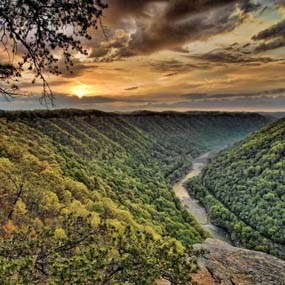
NPS photo/Gary Hartley Climate Change Over time, the New River Gorge has provided a refuge for plants and animals as habitats have shifted with changing weather patterns. As global climate change progresses, New River Gorge National Park and Preserve will provide critical habitat for species displaced from warmer climates. To learn more about the effects of climate change in the park, visit the Effects of Climate Change at New River Gorge National Park and Preserve page. 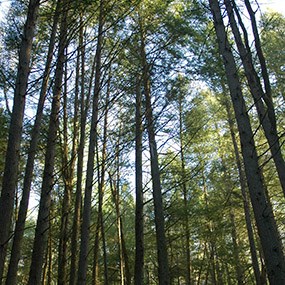
NPS photo/Jodi French-Burr Vegetation Most of the original deciduous forest stands and understory species have been impacted by past and current activities associated with timbering, mining, agriculture, transportation, utilities, and the exclusion of fire. Internal developmentprojects, increasing recreational activities, and expanding commercial and residential influences on the boundary continue to put pressure on a highly fragmented base resource. Power lines and rights-of-way present additional problems. There is currently only limited information on all such areas throughout the park. Right-of-ways are routinely maintained with herbicides application or mechanically treated. There are currently no Special Use Permits in place to regulate this activity. Herbicides are managed through the IPM program. 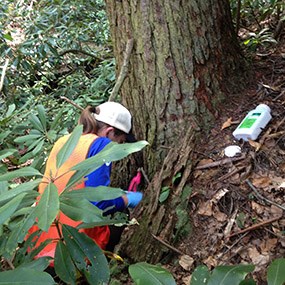
NPS photo Integrated Pest Management Integrated Pest Management (IPM) is also an important issue related to wildlife management. The park lies directly in the path of the leading edge of gypsy moth (Lymantria dispar) infestation. Baseline data on the condition of resources, which would be the indicators of the effects of defoliation, does not exist. Critical documents, such as the Environmental Assessment for gypsy moth management, require detailed information and hard scientific data in order to justify management actions. Another IPM issue is the spraying of the pesticide Bti in the park to control blackflies (Simulium jenningsi). A 1987 law directed the NPS to allow the state to conduct this spraying, which is a very controversial practice. Due to concerns that the removal of all the black fly larvae will negatively impact the overall function of the river ecosystem, the law also directed the NPS to study the effects of the spraying. In cooperation with researchers from Virginia Polytechnical Institute and State University (VPI&SU), a Long-Term Ecological Monitoring System was developed. Preliminary results indicate no short term impacts to the river system. Due to substantial natural variation from year to year in aquatic insect populations of a large river, early results must be described as provisional at best. There are many exotic and pest species within New River Gorge National Park and Preserve, Gauley River National Recreation Area and Bluestone National Scenic River including japanese knotweed, kudzu, poison ivy, yellowjackets, japanese honeysuckle, japanese beetles, etc., for which IPM Plans have been developed. These pest species require a variety of control methods and are treated when their numbers exceed a predetermined injury level. Check out the invasive species pages on this website to learn more about the threats posed by non-native plant and animal species. 
NPS photo/Dave Bieri Minerals Management Many areas within New River Gorge National Park and Preserve, Gauley National Recreation Area, and Bluestone National Scenic River have been impacted by either strip or deep mining for coal, as well as by oil and gas operations. The park has completed an Abandoned Mine Lands Inventory (AML Inventory) for all three units that identifies 115 sites that are abandoned. Many of these sites were abandoned prior to the 1977 Surface Mining Reclamation Act (SMCRA), and are completely or partially unreclaimed. Since 1987, the NPS and the Office of Surface Mining (OSM) have worked together to mitigate the most severe safety hazards identified on this inventory. Three projects have closed 47 portals adjacent to trails and primitive roads, fenced three major mining structures, controlled mine drainage, eliminated highwalls, and stabilized landslide areas. Five sites with multiple openings were closed in 1992 and represented the final funding on the OSM park reclamation project. The park is working with the State Reclamation program to help ensure program continuity and to further extend protection for the public and the environment. 
NPS photo Air Quality All three areas have been designated Class II air quality areas. Air pollution sources resulting from activities within the park includes windblown soil and dust from construction activities, smoke from residential wood burning, automobile emissions, and forest fires. It is also suspected that polluted air from the highly industrial Kanawha Valley (stationary sources that emit more than 100 tons per year) adversely affects air quality throughout the parks. The park has requested technical assistance from the Air Quality Division to assist in a scoping report for air quality issues as a priority in the park Resource Management Plan. Funding has not been available to initiate a parkwide air quality monitoring program. Park staff established a visibility station at Grandview in 1995, to begin the process of baseline data collection. A pilot project for ozone monitoring was also initiated at Grandview.
|
Last updated: January 27, 2021

